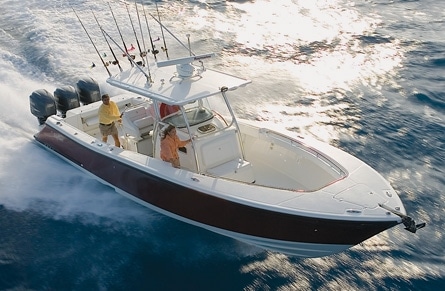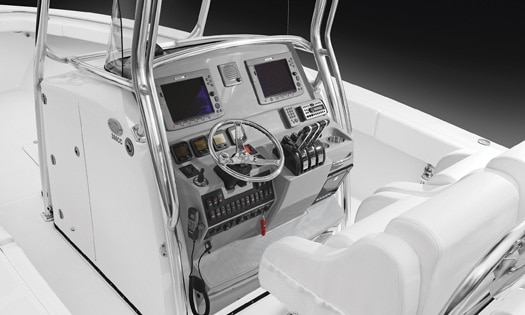
obmay08edge381.jpg
EdgeWater first made its mark by delivering small, well-built boats that offered quality, durability, and safety. Over the years, the company extended its market reach with larger designs but never lost sight of the values that had made its success possible. Once again, the Florida-based builder is stretching its legs and the new 388 Center Console takes EdgeWater’s brand to a new level.
If you are an EdgeWater fan you will likely recognize the pleasant sweep of the 388’s sheer. It seems a refinement of her smaller sister and former EdgeWater flagship the 318 (31 feet, 10 inches). However, if you look more closely you will notice that there is something very different going on below her sheer. The 388’s hull form features a single transverse step-a first for EdgeWater. Originally designed by Michael Peters and offered by Sterling Yachts, EdgeWater was so impressed with the boat’s performance and its seamless fit in their line that they purchased the tooling. After an extensive redesign and retooling the 388 was born.
Michael Peters is a friend but I can tell you honestly that I have yet to find one of his designs that did not impress me. This is particularly true of his single-step hull designs. His portfolio includes a fleet of stepped monohulls as well as a stable of 150-plus-knot multi-stepped cats designed for offshore racing. Designers employ steps to increase lift and reduce drag. “At speed the water and air aft of the step are emulsified-the effect is something akin to running on ball bearings,” said Peters. The 388’s transverse step divides the bottom into two lifting surfaces. To prevent suction, a path for air is provided between them-thus the notch on the 388’s chine. Step placement, angle of attack, and the location of the center of gravity are critical. “Stepped hulls tend to trim one or two degrees less than conventional forms,” says Peters. This keeps the forefoot engaged with the sea and because of the divided running surface drag is minimized.
My sea trial aboard the 388 confirmed my suspicions: Peters’s hull form and EdgeWater’s buttoned-up approach to boatbuilding are a winning combination. Our test boat was fitted with a pair of 350-horsepower four-stroke Yamaha V-8 outboards. I measured a top speed of 46.1 knots (5700 rpm) with the motors trimmed up modestly. Easing her back to 4000 rpm produced a comfortable 28.7 knot cruise and the engine electronics indicated a fuel burn of 28.2 gallons per hour. This adds up to a range of more than 400 nautical miles-ideal for wandering the Bahamas. Fuel is carried in a 340- gallon main tank and a 120-gallon auxiliary that can be selected remotely from the helm. The 388 is also offered with three 350-horsepower Yamahas, a package that EdgeWater’s data suggests will deliver a maximum speed of approximately 60 knots. Personally, I favor the twinengine setup as the performance seems a better match for a diving and sportfishing platform. Like most stepped hulls, the 388 is less animated when interacting with a head sea; but she is not overly stiff longitudinally. Her forward sections soften things up without a fuss or spray and what’s left of the seas pass efficiently aft. Power-assist steering allows finger-tip control of her 800-pound motors and she tracks true, banking and turning predictably. Acceleration is even with little bow rise and she planes at about 16 knots without her tabs. A bow thruster is standard, which makes sense on an outboard-powered boat of this size.
The 388’s hull is built using a resin-infusion method EdgeWater calls SPI (Single Piece Infusion). Stitched reinforcement materials are arranged in female tooling and sealed with a plastic membrane. A vacuum is drawn and catalyzed vinylester resin is flowed into the material to form the laminate. This includes the wetting out of the reinforcement surrounding the foam-cored stringers and web frames, eliminating problems with secondary bonding. The process allows precise control of the resin content and produces a stronger, lighter, and more consistent result than conventional hand lamination. Once the hull is complete, voids between the stringers are filled with foam and the deck/liner molding is bonded and mechanically fastened to the hull. According to EdgeWater the 388 is unsinkable. Hulls are finished with Imron and the deck, liner, and console are finished in gelcoat.

| | |
EdgeWater’s high standard includes gasketed hatches that are finished on the inside and fitted with positive latches. High quality 316L stainless steel hardware and powder-coated aluminum pipe work are typically one size larger than you might expect. The console is laid out with enough space for two large displays and the usual assortment of extras. Controls are comfortably positioned-although I would reposition the engine instrumentation slightly higher as the wheel prevents a clear view. The drop-bolster seat has integral tackle storage and provides a stable leaning post or a comfortable perch at speed. A door in the console allows access to an enclosed head with a freshwater sink and a handheld shower. This dry location also has standup rod storage and is home to the electrical panel and a compartment for the batteries.
There are two in-sole fish boxes aft with overboard discharge. A hatch on centerline allows access to a bilge service and stowage area with an aluminum diamond-plate sole bonded to the hull’s inner skin. While aluminum is stout, synthetic (vinyl) diamondplate might be a better choice given the potentially damp location. A fold-down transom bench seat tucks out of the way to clear the cockpit for fishing. Rod storage is under the gunwales. A sink and a livewell are built into the transom and a door allows access to the platform. There is more seating and storage forward as well as an additional in-sole fish box. A hatch covers the recessed anchor windlass and a washdown tap is provided for tidying up ground tackle. Our test boat was fitted with a first-rate factory fiberglass hardtop that I highly recommend.
EdgeWater builds about 600 boats a year, including production and customized boats for recreational, commercial, and military applications. This experienced yard offers the perfect environment to build a sophisticated boat like the 388. EdgeWater’s plan is to deliver about 15 of these center console boats per year. I’m quite sure that those who sign up for one won’t be disappointed.
EdgeWater Power Boats, (386) 426-5457; www.ewboats.com









